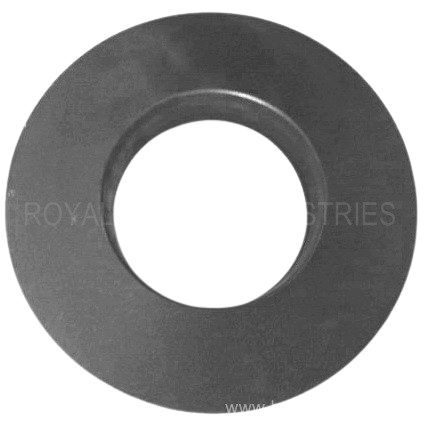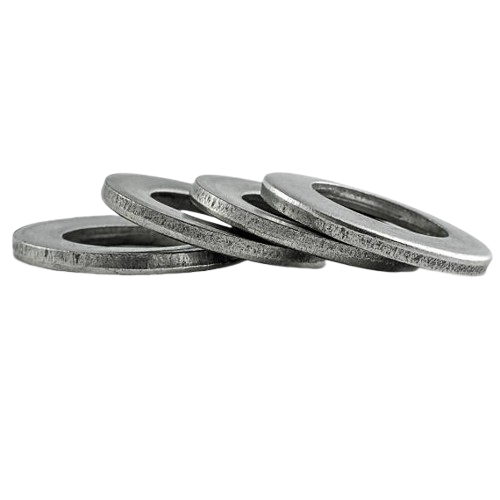Disc Spring




Disc Spring Manufacturers
We are leading Disc Spring Manufacturers up to the following capacity :
- Thickness – Up to 20 mm.
- Outer diameters – Up to 400 mm.
- Inner diameters – As per Drawing / Data.
- Height – As per Drawing / Data.
Raw material grades :
Following Raw material grades are used in Disc Spring manufacturing :
- BS:970 EN42
- BS:970 EN45
- BS:970 EN47
- 50Cr.V4
- 50Cr.4V2
- 51Cr.V4
- 50Cr.MoV4
- 50Si7
- 55Si7
- 60Si7
- SUP9
- SUP9A
- SAE 5160
- others similar Foreign Grades JIS, ASTM etc.
Manufacturing process :
Disc Spring manufacturing is done by the following step by step process :
- Material selection : Choosing the appropriate material (steel, stainless steel, etc.).
- Cutting : Cutting the raw material to the desired size and shape.
- Forming : Shaping the disc spring using stamping, pressing, or hydraulic forming.
- Heat treatment : Heat treatment (tempering, quenching) to enhance the mechanical properties.
- Surface finishing : Applying coatings or surface treatments for corrosion resistance and durability.
- Testing and quality control : Performing load-deflection tests, fatigue tests, and visual inspections.
- Packaging and delivery : Final packaging and shipping.
Why we are most trusted Disc Spring manufactures ?
- Our 40 years of experience
- Rigorous quality control system
- Competitive pricing
- Worldwide customer satisfaction
- Guaranteed performance
Disc Spring DIN 2093 :
Disc Spring DIN 2093 is a German standard that specifies the design, materials, and performance characteristics for Disc Springs. It’s designed to this standard are commonly used in applications requiring high load-bearing capacity and consistent spring performance in a compact form.
Geometry and dimensions :
- Outer diameter (OD) : The total diameter of the Disc Spring DIN 2093 .
- Inner diameter (ID) : The hole in the center of the Disc Spring DIN 2093 typically designed to fit around a bolt or shaft.
- Thickness (t) : The thickness of the Disc Spring DIN 2093 at the thickest part of the cone.
- Free height (h0) : The height of the Disc Spring DIN 2093 in its uncompressed state.
- Spring deflection : The amount by which the Disc Spring DIN 2093 deflects under a given load. This property defines how much the spring can compress under a load and is essential for its performance.
Material specifications :
- Spring steel (e.g., 65Mn, 60Si2MnA) : Offers a good balance of strength, flexibility, and fatigue resistance.
Stainless steel (e.g., AISI 301, AISI 304, AISI 316) : Used for corrosion-resistant applications for Disc Spring DIN 2093. - Alloy steel : For high strength applications in Disc Spring DIN 2093. Materials should meet the mechanical properties specified by the standard, such as tensile strength, yield strength and hardness
Load deflection characteristics :
- Load capacity : DIN 2093 defines the load-bearing capacity of the Disc Spring DIN 2093 for specific dimensions. It helps ensure that the spring can withstand the required loads in dynamic and static applications.
- Spring rate : This is the rate at which the Disc Spring DIN 2093 deflects under load (force per unit of deflection). The spring rate depends on the material, the thickness of the disc, and the design.
- Deflection : The deflection (compression) of the Disc Spring DIN 2093 under a load is important for applications requiring shock absorption or preload maintenance.
Disc Spring uses :
Disc Springs has wide uses across different industries due to their ability to provide high load-bearing capacity, absorb shocks, and maintain consistent pressure or preload in compact spaces. Below are some of the primary uses of Disc Springs :
- Bearing Preload : Maintains axial load on ball or roller bearings to reduce vibration and extend bearing life.
- Clutches & brakes : Applies constant pressure in automotive clutches or rail brake systems.
- Suspension systems : Acts as a compact shock absorber.
- Valve train : Used in some high-performance engines to maintain valve tension.
- Bolt preloading : Prevents bolt loosening due to vibrations or thermal cycling.
- Press tools : Applies consistent force for punching or forming.
- Circuit breakers : Ensures contact pressure in electrical connections.
- Thermal switches : Reacts to expansion and contraction due to temperature changes.
- Pipeline flanges : Maintains sealing pressure in high-temperature, high-pressure environments.
- Safety valves : Controls load and ensures precise valve actuation under varying conditions.
- Landing gear systems : Absorbs high impact loads during touchdown.
- Actuator systems : Provides controlled movement and load distribution.
